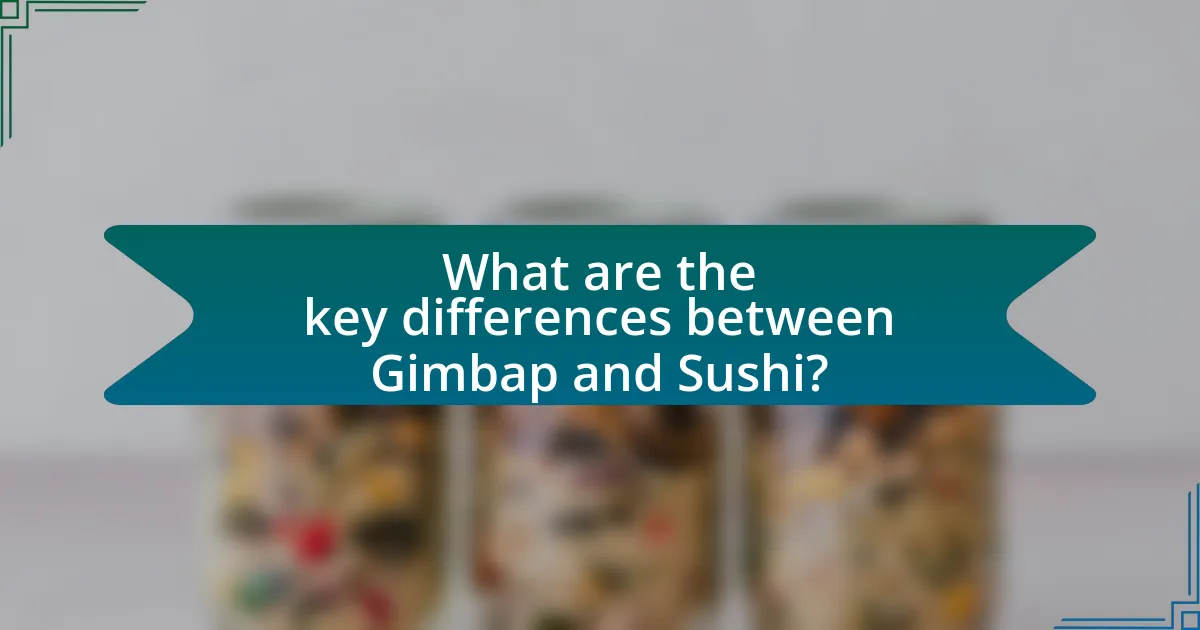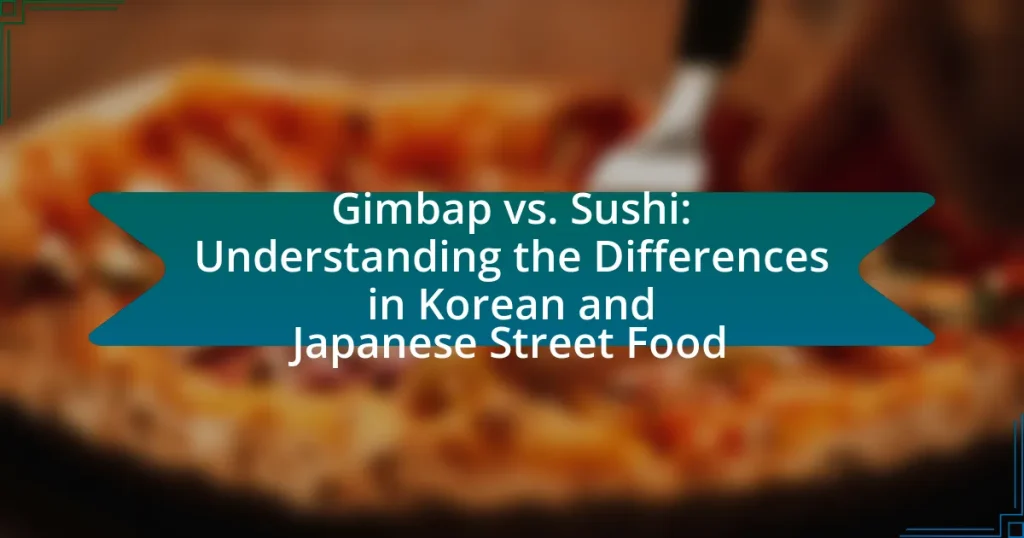Gimbap and sushi are two distinct dishes from Korean and Japanese cuisines, respectively, each with unique ingredients, preparation methods, and cultural significance. Gimbap, made with cooked rice and various fillings wrapped in seaweed, is often enjoyed as a snack or picnic food in Korea, while sushi features vinegared rice paired with raw fish or seafood, emphasizing freshness and artistry in presentation. The article explores their origins, key differences in ingredients and flavor profiles, nutritional values, and common misconceptions, providing a comprehensive understanding of these popular street foods. Additionally, it offers insights into how to enjoy and prepare both dishes at home, along with etiquette tips for social dining settings.

What are Gimbap and Sushi?
Gimbap is a Korean dish made of rice and various ingredients rolled in seaweed, while sushi is a Japanese dish that typically consists of vinegared rice paired with seafood, vegetables, or other ingredients. Gimbap often includes fillings like pickled vegetables, eggs, and meats, and is served in bite-sized pieces, making it a popular snack or picnic food in Korea. Sushi, on the other hand, can vary widely in style, including nigiri (slices of fish on rice), maki (rolled sushi), and sashimi (slices of raw fish without rice). The preparation methods and flavor profiles differ significantly, with gimbap being less reliant on raw fish and more focused on cooked or pickled ingredients, while sushi emphasizes fresh seafood and vinegared rice.
How do Gimbap and Sushi differ in their origins?
Gimbap and sushi differ significantly in their origins, with gimbap originating in Korea and sushi originating in Japan. Gimbap has roots in traditional Korean cuisine, where it was influenced by the need for portable meals, particularly during the Joseon Dynasty, while sushi evolved from ancient preservation methods in Japan, particularly the fermentation of fish with rice. Historical records indicate that gimbap became popular as a convenient food for picnics and celebrations, whereas sushi’s development was closely tied to the evolution of rice and seafood preservation techniques in Japanese culture.
What cultural significance do Gimbap and Sushi hold in their respective countries?
Gimbap holds significant cultural importance in South Korea as a traditional dish often associated with family gatherings, picnics, and celebrations, symbolizing togetherness and community. It is commonly made with rice, vegetables, and protein, wrapped in seaweed, and is a staple in Korean cuisine, reflecting the country’s agricultural practices and seasonal ingredients. Sushi, on the other hand, is a vital part of Japanese culture, representing artistry and precision in food preparation. It is often served in various forms, such as nigiri and maki, and is celebrated for its aesthetic presentation and emphasis on fresh, high-quality ingredients. Both dishes serve as cultural icons, showcasing the culinary heritage and social practices of their respective countries.
How have Gimbap and Sushi evolved over time?
Gimbap and sushi have evolved significantly over time, reflecting cultural and culinary changes in Korea and Japan. Gimbap originated in Korea during the late 19th century, influenced by Japanese sushi but adapted to local tastes with ingredients like pickled vegetables and sesame oil, making it a popular street food. Sushi, on the other hand, has roots dating back to the 8th century in Japan, initially as a method of preserving fish in fermented rice, which later transformed into the modern sushi we know today, featuring fresh fish and vinegared rice. The evolution of both dishes showcases the integration of local ingredients and preferences, with gimbap becoming a staple for picnics and sushi gaining international acclaim, particularly with the rise of sushi bars in the late 20th century.
What are the main ingredients used in Gimbap and Sushi?
The main ingredients used in Gimbap are cooked rice, seaweed (nori), and various fillings such as vegetables, pickled radish, and protein like beef or fish. In contrast, Sushi primarily consists of vinegared rice, raw fish or seafood, and sometimes vegetables, with nori also used in certain types. Gimbap typically features cooked ingredients, while Sushi often includes raw elements, highlighting the distinct culinary traditions of Korea and Japan.
What types of rice are used in Gimbap and Sushi?
Gimbap uses short-grain rice, typically seasoned with sesame oil and salt, while sushi primarily employs short-grain Japanese rice, often mixed with rice vinegar, sugar, and salt. The short-grain rice in both dishes provides a sticky texture that is essential for rolling and holding ingredients together. This specific type of rice is crucial for achieving the desired consistency and flavor profile in both Gimbap and Sushi.
How do the fillings in Gimbap and Sushi vary?
Gimbap and sushi differ significantly in their fillings. Gimbap typically includes a variety of cooked ingredients such as pickled vegetables, egg, and meats like beef or fish, all rolled in seasoned rice and seaweed. In contrast, sushi often features raw fish or seafood, along with vinegared rice, and may include vegetables like cucumber or avocado. The preparation methods and cultural contexts also influence these fillings; for instance, gimbap is often made for picnics and is designed to be eaten cold, while sushi is commonly served fresh and may be accompanied by soy sauce and wasabi.
How are Gimbap and Sushi prepared and served?
Gimbap is prepared by cooking rice, seasoning it with sesame oil, and then rolling it with various fillings such as vegetables, meat, and pickled items in a sheet of seaweed. Sushi, on the other hand, involves preparing vinegared rice and pairing it with raw fish, seafood, or vegetables, often served as nigiri or maki rolls. Gimbap is typically sliced into bite-sized pieces and served with pickled radish, while sushi is presented with soy sauce, wasabi, and sometimes garnished with vegetables.
What are the traditional methods of rolling Gimbap and Sushi?
The traditional method of rolling Gimbap involves placing a sheet of roasted seaweed (gim) on a bamboo mat, spreading a layer of cooked rice evenly over the seaweed, and then adding various fillings such as vegetables, pickled radish, and protein. The mat is then used to tightly roll the seaweed and rice around the fillings, creating a cylindrical shape, which is sliced into bite-sized pieces for serving.
In contrast, the traditional method of rolling Sushi typically starts with a similar process of laying a sheet of nori on a bamboo mat, followed by a layer of seasoned sushi rice. Sushi often includes raw fish or seafood as a filling, along with vegetables. The mat is used to roll the nori and rice around the fillings, ensuring a tight roll, which is then cut into pieces.
Both methods emphasize the importance of using fresh ingredients and achieving a tight roll for optimal presentation and flavor.
How do presentation styles differ between Gimbap and Sushi?
Gimbap and sushi differ significantly in their presentation styles. Gimbap is typically presented in a more casual manner, often sliced into thick, bite-sized pieces and arranged on a plate with colorful garnishes like pickled vegetables, making it visually appealing and easy to eat. In contrast, sushi is presented with a focus on elegance and artistry, often featuring individual pieces that are carefully arranged, sometimes accompanied by wasabi and pickled ginger, emphasizing the freshness and quality of the ingredients. This distinction reflects the cultural significance of each dish, with gimbap being a popular picnic food in Korea and sushi being a refined culinary art in Japan.

What are the key differences between Gimbap and Sushi?
Gimbap and sushi differ primarily in their ingredients and preparation methods. Gimbap, a Korean dish, typically uses sesame oil, cooked vegetables, and proteins like beef or egg, all rolled in rice and seaweed. In contrast, sushi, a Japanese dish, often features raw fish, vinegared rice, and may include a variety of seafood and vegetables. Additionally, gimbap is usually served as a snack or picnic food, while sushi is often enjoyed as a more formal dining experience. The distinct flavor profiles and cultural contexts further highlight these differences, with gimbap emphasizing savory flavors and sushi focusing on the freshness of raw ingredients.
What are the flavor profiles of Gimbap and Sushi?
Gimbap features a flavor profile that is savory and slightly sweet, primarily due to the sesame oil used in the rice and the variety of fillings such as pickled vegetables, beef, and egg. In contrast, sushi offers a more diverse flavor profile that can range from umami-rich fish and seafood to tangy vinegared rice, often complemented by wasabi and soy sauce. The distinct ingredients and preparation methods of each dish contribute to their unique tastes; for example, gimbap’s use of cooked ingredients contrasts with sushi’s emphasis on raw fish, highlighting the cultural differences in Korean and Japanese cuisine.
How do seasoning and sauces differ in Gimbap and Sushi?
Seasoning and sauces in Gimbap and Sushi differ primarily in their ingredients and flavor profiles. Gimbap typically uses sesame oil, salt, and sometimes vinegar for seasoning, creating a nutty and savory taste, while Sushi often incorporates rice vinegar, sugar, and salt, resulting in a slightly tangy and sweet flavor. Additionally, Gimbap is often served with a sesame oil dip, whereas Sushi is commonly accompanied by soy sauce, wasabi, and pickled ginger, enhancing its umami and spiciness. These differences reflect the distinct culinary traditions of Korean and Japanese cuisine.
What role does umami play in the taste of Gimbap and Sushi?
Umami significantly enhances the taste of both Gimbap and Sushi by providing a savory depth that complements their ingredients. In Gimbap, umami is derived from components like sesame oil, pickled vegetables, and protein fillings such as beef or fish, which create a balanced flavor profile. Similarly, Sushi achieves umami through ingredients like fresh fish, seaweed, and soy sauce, which are rich in glutamates. Research indicates that umami is recognized as the fifth basic taste, contributing to overall flavor complexity and satisfaction in dishes, making both Gimbap and Sushi more enjoyable.
How do the nutritional values compare between Gimbap and Sushi?
Gimbap generally has lower calorie content and fat compared to sushi, primarily due to its ingredients. Gimbap typically includes vegetables, pickled radish, and sometimes protein like beef or egg, wrapped in rice and seaweed, averaging around 200-300 calories per roll. In contrast, sushi often contains raw fish, which can increase its calorie count, with some rolls exceeding 400 calories. Additionally, sushi may have higher sodium levels due to soy sauce and other seasonings. Nutritional comparisons indicate that while both dishes provide carbohydrates and protein, gimbap tends to be lower in calories and fat, making it a lighter option.
What are the calorie counts for typical servings of Gimbap and Sushi?
A typical serving of Gimbap contains approximately 300 to 400 calories, while a standard serving of Sushi ranges from 200 to 500 calories, depending on the type and ingredients used. Gimbap, made with rice, vegetables, and often protein like beef or fish, contributes to its higher calorie count. Sushi, which can include various types such as nigiri or rolls, has a broader range due to differing ingredients and preparation methods. For example, a California roll typically has around 250 calories, while a serving of sashimi may have fewer calories due to the absence of rice.
How do the health benefits of Gimbap and Sushi differ?
Gimbap and sushi offer distinct health benefits primarily due to their ingredients and preparation methods. Gimbap typically includes vegetables, pickled radish, and sometimes protein like beef or egg, wrapped in rice and seaweed, providing a balanced source of vitamins, minerals, and fiber. In contrast, sushi often features raw fish, which is rich in omega-3 fatty acids, promoting heart health and reducing inflammation. Additionally, sushi rice is often seasoned with vinegar, which can aid digestion. The differences in protein sources and preparation lead to varying nutritional profiles, with gimbap being more vegetable-focused and sushi emphasizing seafood benefits.
What are the common misconceptions about Gimbap and Sushi?
Common misconceptions about Gimbap and Sushi include the belief that they are the same dish and that they contain similar ingredients. Gimbap, a Korean dish, typically features cooked ingredients such as vegetables, eggs, and meats, all rolled in rice and seaweed, while Sushi, a Japanese dish, often includes raw fish and vinegared rice. Additionally, Gimbap is usually served as a snack or picnic food, whereas Sushi is often consumed in a more formal dining setting. This distinction highlights the cultural and culinary differences between the two, reinforcing that they are not interchangeable despite their visual similarities.
Why do some people confuse Gimbap with Sushi?
Some people confuse Gimbap with Sushi because both dishes consist of rice and are wrapped in seaweed, leading to visual similarities. Gimbap, a Korean dish, typically includes ingredients like vegetables, pickled radish, and sometimes meat, while Sushi, a Japanese dish, often features raw fish and vinegared rice. The overlap in presentation and the use of similar ingredients contribute to the confusion, despite their distinct cultural origins and flavor profiles.
What myths exist regarding the preparation of Gimbap and Sushi?
Myths regarding the preparation of Gimbap and Sushi include the belief that they are the same dish and that both require raw fish. Gimbap is a Korean dish that typically uses cooked ingredients and vegetables, while Sushi, a Japanese dish, often features raw fish. Additionally, some people think that Gimbap must always include sesame oil, but variations exist that do not use it. These distinctions highlight the unique cultural practices and ingredients associated with each dish, reinforcing that Gimbap and Sushi are fundamentally different culinary creations.

How can one enjoy Gimbap and Sushi in daily life?
One can enjoy Gimbap and Sushi in daily life by incorporating them into meals and snacks, as both are versatile and convenient options. Gimbap, made with rice and various fillings wrapped in seaweed, can be prepared in advance and consumed as a quick lunch or picnic food. Sushi, which consists of vinegared rice paired with seafood or vegetables, can be enjoyed at home or ordered from restaurants for a fresh dining experience. Both foods are rich in nutrients; for instance, Gimbap often includes vegetables and protein sources like beef or tofu, while Sushi provides omega-3 fatty acids from fish. This makes them not only enjoyable but also healthy choices for daily consumption.
What are the best ways to incorporate Gimbap and Sushi into meals?
The best ways to incorporate Gimbap and Sushi into meals include using them as main dishes, side dishes, or snacks. Gimbap can be served as a complete meal due to its combination of rice, vegetables, and protein, making it nutritious and filling. Sushi, with its variety of fish and rice, can also serve as a main dish or be included in a sushi platter for sharing. Both can be paired with dipping sauces like soy sauce or wasabi to enhance flavor. Additionally, they can be included in bento boxes, providing a balanced meal with different food groups. The versatility of Gimbap and Sushi allows them to be adapted to various culinary contexts, making them suitable for casual dining or formal occasions.
How can Gimbap and Sushi be made at home?
Gimbap and sushi can be made at home by preparing rice, filling ingredients, and rolling them in seaweed. For gimbap, cook short-grain rice and season it with sesame oil and salt, then layer fillings such as pickled radish, spinach, and cooked proteins like beef or egg before rolling it in a sheet of seaweed. For sushi, use sushi rice seasoned with rice vinegar, sugar, and salt, and fill it with ingredients like raw fish, avocado, and cucumber, then roll it in nori. Both require a bamboo mat for rolling and can be sliced into bite-sized pieces for serving.
What are some popular variations of Gimbap and Sushi to try?
Popular variations of Gimbap include Tuna Gimbap, which features canned tuna mixed with mayonnaise and vegetables, and Kimchi Gimbap, incorporating spicy fermented cabbage. Sushi variations include Nigiri, which consists of rice topped with raw fish, and Maki, which is rolled sushi filled with various ingredients like cucumber or avocado. These variations highlight the diverse ingredients and flavors characteristic of both Korean and Japanese cuisines.
What tips can enhance the experience of eating Gimbap and Sushi?
To enhance the experience of eating Gimbap and Sushi, consider pairing them with complementary condiments and beverages. For Gimbap, using pickled radish and a light soy sauce can elevate the flavors, while Sushi is often best enjoyed with wasabi and soy sauce. Additionally, consuming these dishes with green tea can enhance the overall taste experience, as the tea’s subtle flavors complement the umami notes in both foods. Studies show that the right beverage pairing can significantly enhance the sensory experience of food, making it more enjoyable.
How can one pair beverages with Gimbap and Sushi?
To pair beverages with Gimbap and Sushi, one should consider the flavor profiles of each dish. For Gimbap, which often features ingredients like pickled vegetables and sesame oil, light beverages such as green tea or a crisp lager complement its flavors well. In contrast, Sushi, particularly varieties with raw fish, pairs excellently with sake or a dry white wine, as these beverages enhance the umami taste of the fish. This pairing is supported by culinary traditions that emphasize balancing flavors; for instance, sake has been traditionally served with Sushi in Japan for centuries, enhancing the dining experience.
What are the etiquette rules when enjoying Gimbap and Sushi in social settings?
When enjoying Gimbap and Sushi in social settings, it is essential to follow specific etiquette rules to show respect for the food and the dining experience. For Gimbap, it is customary to eat it with your hands or chopsticks, and sharing is encouraged, reflecting a communal spirit. In contrast, Sushi should be eaten with chopsticks or your hands, but it is considered polite to dip the fish side into soy sauce rather than the rice side to avoid overwhelming the flavor. Additionally, when consuming Sushi, it is respectful to eat each piece in one bite, as this preserves the integrity of the dish. These practices are rooted in cultural traditions that emphasize respect for food and the dining experience, highlighting the importance of etiquette in both Korean and Japanese culinary customs.


